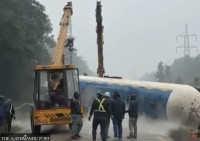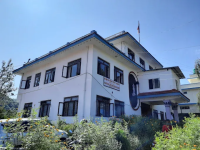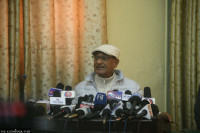National
Janata Party and Samajbadi Party resume informal talks for merger but are stuck at leadership modality
While both parties are on the same page on agendas, leadership management will be key when it comes to unification, leaders say.Tika R Pradhan
The third and fourth largest parties in the federal parliament have resumed talks for unification but with some top leaders sticking to their guns, the process has failed to gain momentum.
Though both Rastriya Janata Party Nepal and Samajbadi Party Nepal appear to be on the same page on most of their agendas, they are not sure how they can manage the leadership, a problem that most of the Nepali political parties have been facing of late.
One major problem, according to Janata Party leaders, is the modality of the leadership they have proposed, to which the Samajbadi Party does not look comfortable.
“We are trying to work on a modality for the leadership, as per which Ashok Rai, who represents the Janajati community, should be ranked third after Mahantha Thakur and Baburam Bhattarai,” said a general secretary of the Janata Party.
This, according to Janata Party leaders, could create some unease for Samajbadi Party Chair Upendra Yadav.
The Janata Party has been saying that major clusters of the Nepali society must be seen prominently in the top leadership and the two parties must be unified in a respectable manner with equal shares for all.
The unity talks between the two parties, which run a coalition government in Province 2, however, are not new.
The two parties started discussing unity months after the 2017 elections. But both the parties joined the KP Sharma Oli government, hoping that they could together push their agendas, including the amendments to the constitution. But nothing happened. At that time, Samajbadi Party was known as Sanghiya Samajbadi Forum Nepal.
The Janata Party brought up unity talks again after March last year, when it quit the Oli government after one of its lawmakers was sent to jail for life in connection with Tikapur violence. It put forth the condition that Yadav quit the government.
In May last year, Yadav merged his party with Baburam Bhattarai’s Naya Shakti to form the Samajbadi Party. The party remained divided for months over quitting the government and forming a unified force with like-minded parties, including the Janata Party, to launch protests for constitutional amendments.
The Samajbadi Party finally quit the government in December last year.
But the same month the Janata Party reached an electoral alliance with the ruling Nepal Communist Party for the National Assembly election. They were trying to work out a larger deal, which also entailed joining the government and extracting the deputy Speaker post. But there has not been any progress in that regard.
Rai, the Samajbadi Party leader, said the Janata Party now seems to have reached a conclusion that it should not join the government.
“Instead, it is considering unification with the Samajbadi Party now,” Rai told the Post. “Informal talks with the Janata Party resumed about a month ago.”
Keshav Jha, a general secretary of the Janata Party, also confirmed that talks at informal level have started.
“One of the major issues is how we should manage the leadership,” Jha told the Post.
Leaders said talks are likely to gain momentum after the Holi festival in the Tarai, which was on Tuesday.
“Once the two parties agree on a common proposal for managing the top leaders of both parties, unification process will move forward,” said Jha.
Janata Party leaders are for unification ensuring equal participation from both the parties on which the leaders of the Samajbadi Party have no objection but the major hindrance they are trying to address is leadership management.
Janata Party is for the top four leaders representing the major clusters of the Nepali society—Mahantha Thakur, Baburam Bhattarai, Ashok Rai and Upendra Yadav—in that order.
“Since the plan is to develop the unified party as a strong alternative force, the major clusters of society must be in the leadership,” said JP Yadav, another joint general secretary of Janata Party.
While the Janata Party is wary of how Yadav will take the leadership modality proposal, the Samajbadi Party is seeking clarity on the part of the Janata Party praesidium.
“Things regarding the unification would become clearer and easier once the six leaders of the praesidium of the Janata Party take a concrete decision,” said Upendra Yadav, chairman of the Samajbadi Party. “Informal talks are going on but for the smooth way forward Janata Party leaders should come up with a formal decision for unification.”
Bhattarai, chairman of Federal Council of the Samajbadi Party, however, said rather than leadership, the unification talks should focus on the agenda.
“Unification talks are moving ahead smoothly,” Bhattarai told the Post. “We will be able to say more once we have a concrete deal.”




 15.12°C Kathmandu
15.12°C Kathmandu













%20(1).jpg&w=300&height=200)

